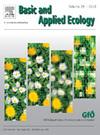站在一起:泥炭地维管植物有利于泥炭藓微地形
IF 3.5
2区 环境科学与生态学
Q2 ECOLOGY
引用次数: 0
摘要
为了保持泥炭地生态系统的异质性和多样性,一个功能良好的植物群落是必不可少的。在完整的泥炭沼泽中,这种群落由泥炭苔藓和维管植物在水文梯度上的平衡混合组成。维管植物与泥炭藓竞争营养和光照等资源,但也为泥炭藓的生长提供结构。泥炭藓是营养型泥炭地的生态系统建设者。相比之下,泥炭苔藓创造了一个不利的环境,只有某些植物物种才能在其中找到一个生态位。鉴于泥炭地植物间存在竞争-促进梯度,维管植物在泥炭地微生境形成中的促进作用主要被忽视。通过在瑞典Store Mosse国家公园进行的长期维管植物清除实验,本研究评估了维管植物群落的功能类型组成作为支持泥炭苔藓(Sphagnum)地毯的机械结构的作用。我们的数据强调了维管植物功能类型多样性在促进泥鳅地毯结构中的重要性。蚁群对小丘的维持至关重要。此外,除去维管束植物后,类柱体的重新定殖使得该微地形中的泥藻地毯得以恢复。禾本科植物最多提供了“共同促进”的结构支持,以泥棉地毯。这些结果表明,维管植物群落的组成决定了它们对结构支持的贡献程度,并表明维管植物群落的恢复可以作为恢复泥炭苔藓微地形的工具,从而导致泥炭地植物群落的异质性和多样性。本文章由计算机程序翻译,如有差异,请以英文原文为准。
Standing tall together: Peatland vascular plants facilitate Sphagnum moss microtopography
To preserve the heterogenic and diverse nature of peatland ecosystems, a well-functioning plant community is imperative. In intact peat bogs, such communities consist of a balanced mix of peat mosses and vascular plants across a hydrological gradient. Vascular plants compete with peat mosses – the ecosystem builders in ombrotrophic peatlands – for resources such as nutrients and light, but also provide structure for peat mosses to grow. In contrast, peat mosses create an adverse environment in which only certain plant species can find a niche. In light of the competition–facilitation gradient between peatland plants, the role of vascular plants as facilitators for peatland microhabitat formation is mainly overlooked.
Using a long-term vascular plant removal experiment in Store Mosse National Park, Sweden, this study assesses the role of the functional type composition of the vascular plant community as a mechanical structure to support the peat moss (Sphagnum) carpet.
Our data highlights the importance of vascular plant functional type diversity in facilitating the structure of the Sphagnum carpet. Ericoids are crucial for the maintenance of hummocks. Moreover, recolonization of ericoids after removal of vascular plants enabled the recovery of the Sphagnum carpet in this microtopography. Graminoids provide at most ’co-facilitation’ of the structural support to the Sphagnum carpet. These results show that the composition of the vascular plant community determines how strongly they can contribute to structural support and indicate that restoration of the vascular plant community can be used as a tool to restore peat moss microtopographies, leading to a heterogenic and diverse peatland plant community.
求助全文
通过发布文献求助,成功后即可免费获取论文全文。
去求助
来源期刊

Basic and Applied Ecology
环境科学-生态学
CiteScore
6.90
自引率
5.30%
发文量
103
审稿时长
10.6 weeks
期刊介绍:
Basic and Applied Ecology provides a forum in which significant advances and ideas can be rapidly communicated to a wide audience. Basic and Applied Ecology publishes original contributions, perspectives and reviews from all areas of basic and applied ecology. Ecologists from all countries are invited to publish ecological research of international interest in its pages. There is no bias with regard to taxon or geographical area.
 求助内容:
求助内容: 应助结果提醒方式:
应助结果提醒方式:


